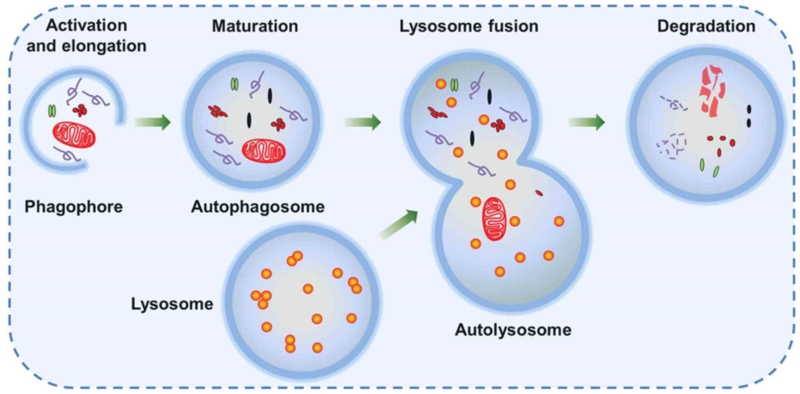Question:
Some statements regarding the process of autophagy are given below:
- Autophagy occurs when cells contain aggregated proteins
- Autophagosomes fuse with any organelles
- Autophagosome is a single membrane structure
- Autophagosomes fuse with lysosomes to form autophagolysosomes
Which one of the following combinations of the above statements is correct?
- A and B
- B and C
- C and D
- D and A
Rephrasing the Question:
What is the mechanism of autophagy?
Answer:
Autophagy can occur when cells contain aggregated proteins, and autophagosomes fuse with lysosomes to form autophagolysosomes (option 4).
Explanation:

Autophagy is the evolutionarily-conserved, regulated mechanism that a cell uses to remove unnecessary or dysfunctional components. It allows the cell to break down and recycle organelles or other cellular components in an orderly fashion.
Autophagy can be caused by multiple things:
- Homeostasis: regulating the number and health of organelles.
- Starvation: In situations of nutrient starvation, autophagy allows cells to recycle unneeded proteins so that they can maintain energy levels to survive.
- Repair: Autophagy degrades damaged organelles, cell membranes and proteins. This includes aggregated and misfolded proteins, especially since these can be resistant to other, more common forms of degradation (like ubiquination).
- Infection:
Autophagy can be divided in categories based on what you’re recycling and how. The most studied form is macroautophagy, in which cytoplasmic components (like organelles) are targeted and enveloped in a double-membraned vesicle known as an autophagosome. This later fuses with a lysosome, to create an autophagolysosome (also known as an autolysosome), and components inside it are then degraded and recycled.

Thanks for sharing this informative post! As someone who enjoys IPLTATA sports, I found your insights on IPLTATA Sports to be really helpful. It’s always interesting to learn about new strategies and tips for maximizing winnings while staying responsible. Looking forward to trying out some of these techniques during my next visit to the IPLTATA sports! Keep up the great work!
ipl tata sports
Podlix Breeze Vapes are a cutting-edge line of electronic vaporizers designed for users seeking a sleek and user-friendly vaping experience. Crafted with precision and style, these devices offer a perfect blend of form and function. With a focus on simplicity, Podlix Breeze Vapes feature easy-to-use controls, ensuring both novices and seasoned vapers can enjoy a hassle-free experience.
Challenge yourself – Play the game that tests your limits Hawkplay
Loveloren is a brand that embodies elegance and versatility across various categories, offering exquisite lingerie, stylish swimwear, dynamic activewear, chic accessories, and fashionable clothing. Each piece in their collection is meticulously designed to blend comfort with high fashion, ensuring that every item enhances the wearer’s confidence and style. From delicate, intricately crafted lingerie to bold, statement-making swimwear, and from performance-driven activewear to versatile accessories and sophisticated everyday clothing, loveloren clothing brand usa caters to a diverse array of tastes and lifestyles. This dedication to quality and design makes Loveloren a go-to destination for those seeking both beauty and functionality in their wardrobe.